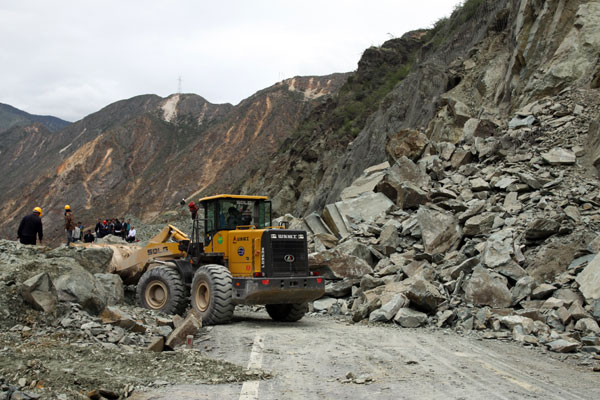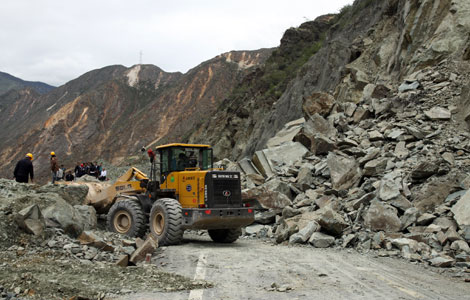Keeping open the lifeline to Tibet
Updated: 2013-10-28 07:38
By Hu Yongqi and Li Yingqing in Deqen, Yunnan (China Daily)
|
||||||||
 |
|
An excavator clears debris on National Highway 214, also known as the Yunnan-Tibet Highway, which runs for 3,256 km. Hu Yongqi / China Daily |
Highway linking the plateau a vital link, report Hu Yongqi and Li Yingqing in Deqen, Yunnan
'Hey, man, watch your back for falling rocks. There's another huge one coming down," shouted Yang Jun to the driver of an excavator clearing debris on National Highway 214.
Just a few seconds later, three large rocks, the biggest estimated at more than 10 metric tons, slammed onto the road. The driver avoided them by turning the excavator's enormous arm out of range, before starting once again on his work of breaking the stones and clearing the road.
On one side of the highway, shattered rocks lie strewn around, while on the other side, the Jinsha River rushes past. Later downstream it becomes the Yangtze River, its waters tinted by yellow soil similar to that found on the Loess Plateau in northwest China.
It's a typical scene on this high-altitude highway where hazards can come from any direction. Two trucks, smashed simultaneously by a landslide, have been left on the road to remind drivers of the potentially risky conditions.
In late October, the only signs of life were the yaks and goats that slowly wound their way between small bushes turned gray by the dust raised by passing vehicles.
On Aug 30, Diqing Tibet autonomous prefecture, in the north of Yunnan province, was hit by a magnitude-5.9 earthquake. Yang, a manager at Sichuan Hydropower Investment and Management Group, was dispatched to Shangri-La in the aftermath of the quake. Yang's company has a contract to clear the existing highway and construct a new one.
When we met, he and his colleagues had been working for more than 50 days to clear the debris. Yang said it was the toughest assignment he'd undertaken in the course of his 25-year career.
"Some of the rocks appear to be stuck to the mountainside, but they'll easily be dislodged if another tremor occurs," he said.
National Highway 214, also known as the Yunnan-Tibet Highway, runs for 3,256 km, stretching from Jinghong city in Xishuangbanna Dai autonomous prefecture in southern Yunnan to Xining city, the capital of Qinghai province. Upon completion in 1974, the road became one of the four main routes for cargo and people entering or leaving the Tibet autonomous region.
Located at an altitude of 3,300 meters, Diqing, whose 373,000 residents live on 23,870 square km of land, still relies heavily on the highway because there is no access to railways or expressways. The Deqen-Zhongdian fault line (Zhongdian county was renamed Shangri-La in 2001) is prone to earthquakes, so the area is sparsely populated - with just eight people per square km - and the locals value the highway.
The road winds up to the summit of White Horse Snow Mountain in Deqen Tibet autonomous county; at around 3,500 meters it's high above the snowline. The road only functions because of the dedication of the maintenance workers who struggle to overcome the climatic extremes during winter and summer.

 Serena completes dominant season with triumph
Serena completes dominant season with triumph
 Nuclear submarine fleet comes of age
Nuclear submarine fleet comes of age
 5 pharmacies begin to sell baby formula
5 pharmacies begin to sell baby formula Mother and four children stabbed to death in New York
Mother and four children stabbed to death in New York
 China Fashion Week S/S 2014: day 2
China Fashion Week S/S 2014: day 2
 Demonstrators protest against govt surveillance in US
Demonstrators protest against govt surveillance in US
 Where art thou, my love?
Where art thou, my love?
 Li Na reaches WTA Championships final
Li Na reaches WTA Championships final
Most Viewed
Editor's Picks

|

|

|

|

|

|
Today's Top News
High speed versus history
Southern states gear up for symposium
Film finds a hip-hop-tai chi connection
Jewelry exhibit dazzles Southern California
Obama aware of spying on Merkel: German paper
Five stabbed to death in NYC
Forum urges stable China-Japan ties
NSA spying hurts US diplomacy
US Weekly

|

|






